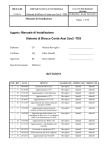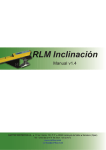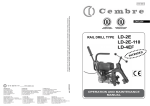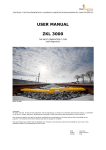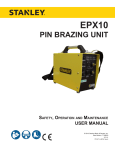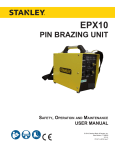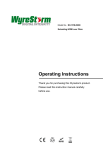Download Installation Manual
Transcript
Installation Manual for KAGO rail contact clamps and KAGO cable fastening clamps 2 List of contents 1. Does the clamp fit your rail profile? 4 2. Installation of rail contact clamps 6 3. Installation of cable fastening clamps 7 4. Removal of clamps 8 5.1. Cable installation for types E2 and E3 9 5.2. Cable installation for type E4 10 5.3. Cable installation for type E5 11 5.4. Cable installation for types GI and EI 12 5.5. Cable installation for type EA 13 5.6. Cable laying of railbonds 14 6.1. Why testing of rail contact clamps? 15 6.2. Test instructions before reuse 16 6.3. Groove cleaning and spring checking 17 3 1. Does the clamp fit your rail profile? Important: Please read carefully! Hundreds of different rails are in use worldwide! The already developed basic types of KAGO clamps integrate this variety to a large extent. The basic types differ in two essential features: Firstly in length and number of the existing slots, by which it is possible to cover different rail base widths. See example below: 1. slot: 125 mm 2. slot: 140 mm 3. slot: 150 mm Basic type C Suitable for the following rails: - 1st slot: S49=Form B, S54, SBB I, DSB 45,UIC54E = SBB IV = Form C. - 2nd slot: UIC54 = SBB III = 54 kg, 98lb, 109lb, 110A, 113A, 113 lb, U36, U50, EB50T, Ri35G=35GP - 3rd slot: UIC60 = SBB VI = UNI60, Ri55, Ri53 4 Secondly the clamps differ in their opening, by which the different rail base forms are covered. See measure „x“ on the right: Because the different clamps are often hardly distinguishable at first sight, we have marked the bottom, namely with the letters „A“, „C“, „D“, „E“, „I“, „J“, „K”, „N“, „P“, „R81“, „R82“, „T“, „U“, „V” „W“, „Y50N“ or „Y60“ etc. Always make sure you are mounting the correct clamp which is perfectly suitable for your rail! In case of uncertainty please refer to the „KAGO Clamp Directory“ which includes information about the different basic clamp types as well as the most common rails. Caution: If clamps are mounted on unsuitable rails, their function is not guaranteed due to incomplete fitting or insufficient clamping pressure! The worst case is overstretching (for example at switches) which could even result in clamp breakage! 5 2. Installation of rail contact clamps Caution: Use a hammer with the ideal weight between 1 and 2 kilograms for mounting and removal. It must not be heavier than 2 kg, otherwise the clamp or the spring could be damaged. Place the clamp on the rail base and give it a few light taps (I) so that it gets a bit of tension and starts to grip. Pay attention that you hit the curve and not the head of the clamp while hammering! Afterwards three hard blows will normally do to mount the clamp sufficiently. After reaching the stop (II), the clamp will automatically click into place at the rail base‘s lower edge (III). If the clamp jumps back – which can above all happen with brand-new clamps –, repeat the procedure: At first use light taps, then hit hard. Make sure the clamp is gripping properly at the front and back! Don‘t forget: The clamp functions like a spring and therefore has a tremendous inherent strength. This is necessary, so that the teeth bite firmly and permanently into the rail, through brake dust, grease, rust or other residue. Please wear safety goggles and ensure that nobody is standing in front of or behind you during the whole mounting procedure! Duration of installation: KAGO contact clamps are mainly used for temporary electric connections. However they can also stay built in permanently for years or even decades without any problem. Even the most intense clamp vibrations can do no harm, assuming correct installation directions have been followed. An oxidisation of the contact points is effectively prevented long term, due to the pressure remaining constant over years. 6 3. Installation of cable fastening clamps Fastening clamps are basically mounted in the same way as contact clamps (see chapter 2)! To protect the pipe from damage – caused by tamping or other track maintenance machines –, mount it next to the sleeper as close as possible, as shown in the pictures. 7 4. Clamp removal of contact and fastening clamps Contact spring: For type E4, remove the spring before detaching the clamp from the rail! Using gentle blows on the notches (fig. I) or the small area at the top of the contact spring, you can free it and slide it out. Please refer chapter 6.2! For type E2/E3 we recommend the opposite procedure. Please refer chapter 6.1! Clamp: Detach the clamp from the rail with a well-aimed hammer blow from above on the tip of the clamp (fig. II). Because the mounted clamp is under mechanical pressure, it is important that you ensure nobody is standing behind or in front of you during the process. Protect yourself by placing the sole of your shoe in the direction of the clamp head. Caution: Never strike the side of the clamp (fig. III), because this will impair its spring pressure and ruin it for further use as a contact clamp! 8 5.1. Cable installation for types E2 and E3 Before mounting the wire or the cable, first remove the contact spring. This is done most easily by gently hammering on the front end of the contact spring, before the clamp is mounted to the rail (ill. left). Otherwise knock the spring out by wellaimed hits with the pointed end of the hammer (ill. right). Some connecting possibilities: Groove 7 mm 6 mm 10 mm 3 mm Typ E2 Wire type / Cable cross-section Wire ø 7 mm Wire ø 6 mm or flexible cable 25 mm2 / 35 mm22 2 Flexible cable 50 mm or highly flexible 70 mm Wire ø 3 mm or flexible cable 4 mm2 Groove 8 mm 5 mm 10 mm 3 mm Typ E3 Wire type/ Cable cross-section Wire ø 8 mm or flexible Cable 50 mm22 highly flexible Wire ø 5 mm or flexible Cable 16 mm 2 Flexible cable 50 mm or highly flexible 70 mm2 2 Wire ø 3 mm or flexible cable 4 mm Before use please check if wire/cable fits and in which groove! Lay the bright cable or wire into the correct groove (I) and push the contact spring through the rear slot (II) over the cable into the front slot. Now hammer (I) contact spring to the stop (II). the spring, an exis guaranteed! the onto the clamp head up Due to the pressure of cellent electrical contact Caution: Use only one cable at a time! 9 5.2. Cable installation for type E4 Before fixing the cable, the contact spring must be removed. This is done most easily when the clamp is still mounted on the rail, namely with gentle taps on the notches (ill. left) or the small area at the top of the contact spring (in the picture between forefinger and thumb). Simultaneously slide the spring out of the clamp. Some connecting possibilities: Groove 5-6 mm 7-10 mm 11-16 mm 17-21 mm Cable type Stranded wire Flexible cable Flexible cable Flexible cable Cross-section 15 mm2 35/50/70 mm2 120 mm2 240 mm2 Afterwards lay the stripped cable into the correct groove (I) and slide the contact spring from behind into the clamp head (II). The cable must be slightly clamped by the spring pressure, and the contact spring must hold its position by itself. Before use please check if cable fits and in which groove! Now hammer (I) the contact spring onto the clamp head up to the stop (II). The notches hold it in position. Due to the pressure of the spring, an excellent electrical contact is guaranteed. Caution: Not appropriate for stiff cables! Use only one cable at a time! 10 5.3. Cable installation for type E5 Connecting type E5 has been developed as a complement to type E4 and is delivered with the loose clamping counterpart (I), the horizontal adjustment part (II), a locking plate (III) and a screw M16x50 (IV). IV III II I In both grooves, steel, bronze and copper wires and cables with diameters between 9 and 14 mm can be clamped. This corresponds with cable cross-sections of ca. 50–120 mm2 according to the conductor structure. When using big cross-sections, it is recommendable on the one hand to leave out the washer, so that the screw can be screwed in deeply enough, on the other hand both grooves should be occupied with the cable to guarantee an optimal contact pressure. Caution: To avoid loose cable connections, make absolutely sure new locking plates are correctly mounted for every renewed cable mounting! For mounting tips please refer to the end of chapter 5.4. at the bottom of the next page. 11 5.4. Cable installation for types GI and EI Place the cable lug (I), the locking plate (II) and the bolt (III) on the clamp. Type GI: Suitable for cable lugs up to 150mm22. Type EI: Suitable for cable lugs up to 240mm . Afterwards tighten the bolt according to the dimension of the thread: Thread M8 M10 M12 M16 Tightening torque in Nm 15 30 50 120 To prevent the bolt from loosening even through massive vibrations, hammer the longer flap of the locking plate down towards the side of the clamp (ill. right) and the shorter flap up towards the bolt (ill. left). Caution: To avoid loose cable connections, make absolutely sure that new locking plates are correctly mounted for every renewed cable mounting! 12 5.5. Cable installation for type EA Place the cable lug and the re-usable self-locking nut on the clamp. Then tighten the nut according to the dimension of the stud: Stud M8 M10 M12 M16 M20 Tightening torque in Nm 15 30 50 120 240 Type EA: Suitable for cable lugs up to 240 mm2. Caution: To avoid loose cable connections, please ensure that you always apply re-usable or new locknuts for every renewed cable mounting! 13 5.6. Cable laying of railbonds To protect the cable from damage – caused by tamping or other track maintenance machines –, lay it as close as possible to rails and sleepers, as shown in the pictures. 14 6.1. Why testing of rail contact clamps? KAGO rail contact clamps were not only developed for one-way use. On the contrary: If they are always mounted correctly, KAGO clamps have a very long lifetime and can be used again and again! Of course their clamping pressure could slightly decrease with every repeated fastening, so that a testing of the clamping pressure is recommendable before using KAGO clamps again! After all they have an important role to play in railway safety, which means they must be absolutely dependable! The testing must be done with the KAGO testing gauge: If the clamp holds on the precision pin, the function is guaranteed (fig. a). If it falls through, it is no longer usable (fig. b). When it comes to railbonds, do not forget to take the opportunity to also check the condition of the cables! Caution: The existing testing gauge loses its validity for clamps with the lot marking C26... (see clamp bottom). We look forward to offering you a new testing gauge for C26... clamps! 15 6.2. Testing instructions for KAGO clamps (1) Tighten the testing gauge in a vice. (2) Place the clamp onto the precision pin of the testing gauge from above. (3a) Good: Clamp holds on the pin, i.e. it can be re-used. (3b) Bad: Clamp falls through, i.e. it is no longer usable. 16 6.3. Groove cleaning and spring checking (only for connecting types E2, E3 & E4) Low voltage connections (1,5-12 Volt) are only guaranteed as long as each KAGO clamp is tested after use with the gauge and if dirty grooves have been cleaned by means of a steel brush and a liquid cleaner (like paraffin) if required! E2 E3 Contact springs can break when mounted carelessly (too hard hits, canting, etc.)! They must be treated – unlike the clamp itself – as wearing parts that have to be replaced when signs of wear and tear like deformations, cracks, etc. appear! E4 17 18 19 The policy of KAGO AG is one of continuous development. The company therefore reserves the right to change specifications and introduce design improvements at any time and without notice. For more detailled information please refer to our „KAGO Clamp Directory“! This installation manual must be strictly obeyed and no KAGO clamps must be modified mechanically or by welding, otherwise any product liability will be rejected. The latest update of this booklet can be found on http://www.kago.com/pdf/e_62_mi.pdf Copyright by KAGO AG. All rights reserved. Version 19.11.2012 20






















